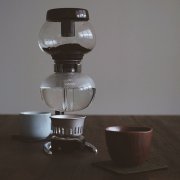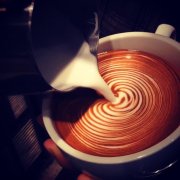Recommendation of bean grinder with stable ratio of coarse and fine powder
The reason why the bean grinder is important is that it is the most important processing link before coffee is extracted. Here we briefly share with you the most important elements in the whole coffee chain: 1, coffee tree, it is the most important element in the plantation; 2, the processing process of coffee, it is the most important link before coffee comes out of the plantation. 3. Roaster, which is the key equipment to turn raw coffee beans without coffee flavor into roasted coffee with rich flavor. 4. Bean grinder, which is the starting point of roasting coffee beans on the bar. 5. Extraction equipment. Therefore, the importance of bean grinder.
So what is a good bean grinder? Some knowledgeable friends will say: grind even bean grinder. In fact, a completely uniform coffee grinding does not exist. At present, the coffee powder produced by any coffee grinder is composed of coarse powder, medium-fine powder, fine powder and very fine powder. These coffee powders of different particle sizes play different roles in the process of coffee extraction, some are used to form alcohol thickness, and some are used to show flavor. So even if there is a completely uniform bean grinder, the flavor of the coffee is very mediocre. If you have the opportunity to use different mesh sieves, the ground coffee powder will be sifted and then made, the effect will be clear at a glance.
We say that an excellent coffee grinder refers to a bean grinder with a stable proportion of coarse and fine powder. at present, many famous bean grinder manufacturers have applied a lot of high technology, and its purpose is to pursue the stability of the proportion of coarse and fine powder in coffee powder. On the other hand, some cheap bean grinders are far from stable in the proportion of coarse and fine powder in coffee powder. This time, fine powder accounts for 15%, and next time it may be 30%. It seems that a thick layer of fine powder is covered under the thicker grinding particles. Therefore, the coffee powder ground by such a bean grinder can not be extracted scientifically, because grinding is not only the premise of extraction, but also one of the important factors to show coffee flavor.

Important Notice :
前街咖啡 FrontStreet Coffee has moved to new addredd:
FrontStreet Coffee Address: 315,Donghua East Road,GuangZhou
Tel:020 38364473
- Prev

Characteristics of siphon pot for making coffee Japanese coffee utensils
After 2003, the third wave of boutique coffee sprang up, leading to the revival of follicular black coffee. Hand flushing and siphon pots have become the necessary wardrobe for the third wave of boutique coffee fashion in Europe and the United States. However, the skills of hand flushing and siphon pots are really very bad. If you are lazy people who like drinking good coffee and don't want to hurt your nerves, you might as well use your clever domestic Abid Clever D filter cup.
- Next

Special coffee what is special coffee?
Nowadays, you can always hear the word "special coffee" in the coffee circle. In the past, almost every cup of coffee was called special coffee, but the wave of coffee represented by this word has not officially sprung up until today. According to the authoritative interpretation of the American Special Coffee Association (SCAA), special coffee (cooked beans) refers to those made of high quality, carefully roasted and professionally brewed, which can highlight the purest and most
Related
- Beginners will see the "Coffee pull flower" guide!
- What is the difference between ice blog purified milk and ordinary milk coffee?
- Why is the Philippines the largest producer of crops in Liberia?
- For coffee extraction, should the fine powder be retained?
- How does extracted espresso fill pressed powder? How much strength does it take to press the powder?
- How to make jasmine cold extract coffee? Is the jasmine + latte good?
- Will this little toy really make the coffee taste better? How does Lily Drip affect coffee extraction?
- Will the action of slapping the filter cup also affect coffee extraction?
- What's the difference between powder-to-water ratio and powder-to-liquid ratio?
- What is the Ethiopian local species? What does it have to do with Heirloom native species?

